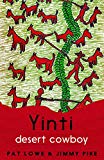The stories of Yinti are based on real people and events as told to Pat Lowe by artist Jimmy Pike. By the time he is in his early teens, Yinti can provide for his own needs, is a good hunter, knowing the position of every waterhole and how to dig for water. His traditional lifestyle in the Great Sandy Desert of Western Australia is changing radically as he and his family are some of the last people to walk into kartiya (whitefella) owned cattle stations that are gradually colonising the desert lands.
Yinti and his cousin Wara leave their family, travelling across the desert to Cherrabun cattle station. Ridiculed for their nakedness, the boys are supplied with clothes made of flour bags and put to work, for 'dirty black pennies' that bought sweets, learning English as they work. Moving to the fringe dweller camps, they are given rations of bread, sugar, tea and blankets. The boys decide to visit their families, arguing that 'We can’t stay here in our country much longer - everyone else has gone’…. the sandhills were eerily empty of people' (page 5). In a reversal of roles, the boys persuade their families to move to the cattle station, showing their elders the waterholes and introducing them to different plants and animals.
Yinti becomes a competent stockman, given 'proper' shirts and trousers and a horse, Star. They work closely together for a few years before Star is felled by lightening in a terrible storm. Their relationship is the warmest depicted in the story, surpassing even the episode describing the devastating epidemic of flu that kills his mother.
Overall, the tone of Lowe’s narrative is devoid of empathy. As fringe dwellers, Yinti’s mob are ensnared into a system of slave labour, paid a pittance and treated as expendable commodities. Cattle work is cruel to the animals and dangerous for the workers. When Yinti breaks a leg, the station manager, Longnose, orders, ‘Get mended soon. Then come back to work. You’re no good to anyone like that.’ ‘Righto, boss,’ said Yinti. (page 78)
When the new manager 'talks to us like dogs' (page 80) and pays them even less, Yinti and Wara leave. Ending up at a sheep station, where mutton is plentiful and kangaroo numbers are unchecked, Yinti learns to hunt with rifles. The boys’ attitudes towards killing animals is culturally and morally bound. They refuse to slaughter feral donkeys, because donkeys 'used to work for people…before motor cars'. (page 100) Unknowingly, they kill a tame emu, the sheep station pet.
Able to read the land and the landscape, Yinti finds shards of bones; evidence of massacre of Aboriginal people. Returning to the station, watching the boss and his missus at dinner, Yinti has 'the power of life and death in his index finger.' (page 106) Yinti’s station life ends abruptly when he undergoes public shaming for his relationship with another man’s wife.
Jimmy Pike’s vivid texta colour illustrations depict station life and Yinti’s desert country as full of action and life. His life and work as an artist are detailed in the Teaching Resources. 'Jimmy Pike (approximately 1940-2002) was a Walmajarri man of the Great Sandy Desert and prolific artist intent on sharing his knowledge and love of his desert home.' (Australian Institute of Aboriginal and Torres Strait Islander Studies - see Teaching Resources)
Series: Yinti, no 3

